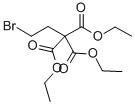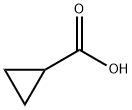Triethyl 3-bromopropane-1,1,1-tricarboxylate (TRI) is a purine that is used as a supplement in the form of its salts. It is an active compound for treating herpes simplex virus type 1 and 2 (HSV-1 and HSV-2). TRI inhibits viral replication by acting on the viral DNA polymerase and blocking the synthesis of DNA, which prevents viral replication. TRI also inhibits cellular protein synthesis by inhibiting ribonucleotide reductase and guanosine kinase. TRI can be synthesized using a catalytic process or a hydrogenolysis process. Catalytic processes are generally preferred because they are more economical than hydrogenolysis processes; however, both methods produce impurities that must be removed before the desired product can be. Triethyl 3-bromopropane-1,1,1-tricarboxylate is used as the side chain of the pharmaceutical intermediate Famciclovir. Famciclovir is a purine nucleoside analogue and an oral prodrug of penciclovir. It was first marketed in the UK in 1993 by the British company SKB for treating shingles.







